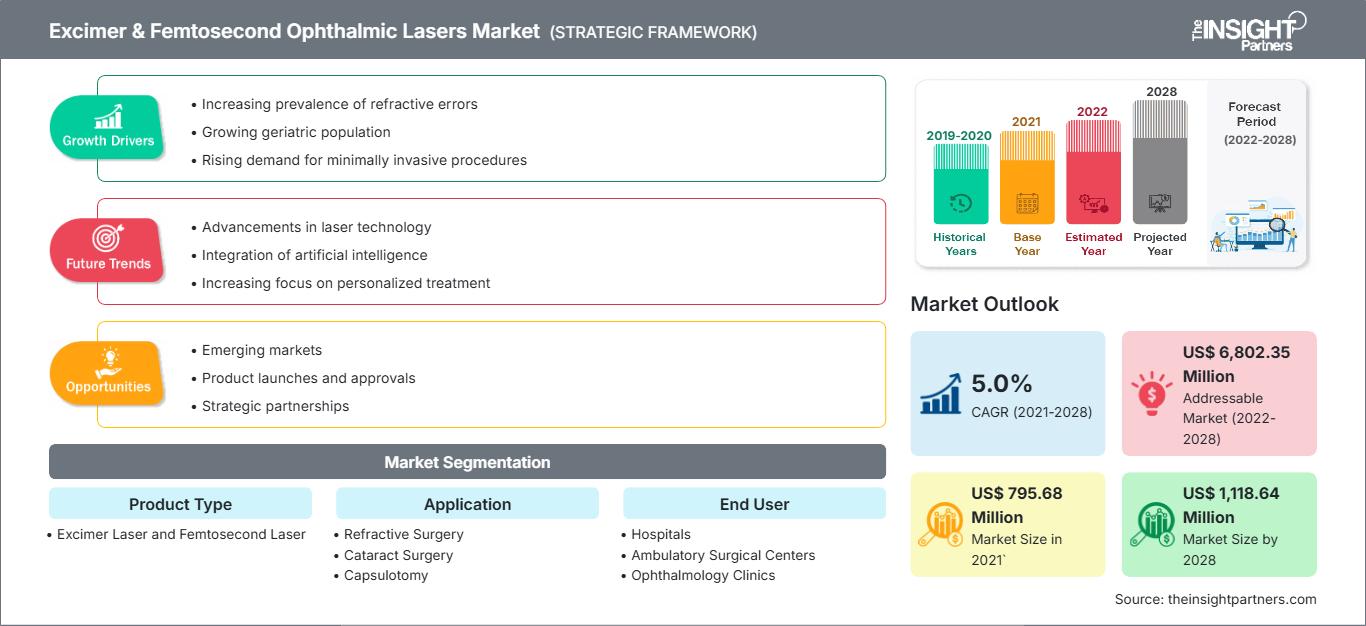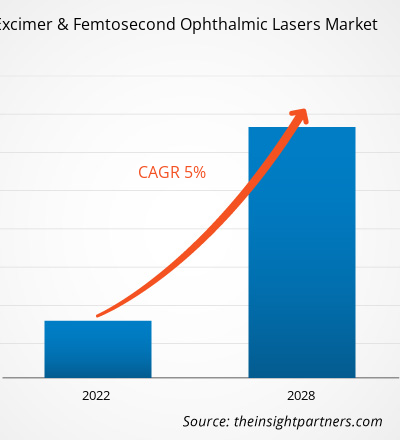Se espera que el mercado de láseres oftálmicos excimer y femtosegundo alcance los US$ 1.118,64 millones para 2028 desde los US$ 795,68 millones en 2021; se estima que crecerá a una CAGR del 5,0% entre 2021 y 2028.
La tecnología láser se utiliza en muchas disciplinas y especialidades médicas y desempeña un papel importante en el avance de la oftalmología, especialmente en la cirugía refractiva corneal. El láser oftalmológico es de dos tipos: láser excimer, queratectomía fotorrefractiva (PRK), queratomileusis epitelial láser (LASEK), queratomileusis in situ con láser epipolis (Epi-LASIK) y queratectomía fotorrefractiva transepitelial (Trans-PRK) y cirugía de presbicia. El láser femtosegundo, como la queratomileusis in situ con láser femtosegundo (FS-LASIK), la inserción de segmentos de anillo intracorneales, la extracción de lentículos con incisión pequeña (SMILE) y la extracción de lentículos con femtosegundo (Flex).
Cobertura del informe
El crecimiento del mercado de láseres oftálmicos de excímero y femtosegundo se atribuye a factores como el aumento de la población de edad avanzada y el incremento de las cirugías de cataratas y refractivas. Sin embargo, el alto costo de las cirugías y dispositivos oftalmológicos frena el crecimiento del mercado.
Obtendrá personalización en cualquier informe, sin cargo, incluidas partes de este informe o análisis a nivel de país, paquete de datos de Excel, así como también grandes ofertas y descuentos para empresas emergentes y universidades.
Mercado de láseres oftálmicos de excímero y femtosegundo: Perspectivas estratégicas

-
Obtenga las principales tendencias clave del mercado de este informe.Esta muestra GRATUITA incluirá análisis de datos, desde tendencias del mercado hasta estimaciones y pronósticos.
Perspectivas del mercado
Aumento significativo de la población de edad avanzada
El aumento de la población geriátrica en países como EE. UU., Reino Unido, Canadá, Japón, China, India y Corea del Sur está impulsado por la modernización de las instalaciones de atención médica y las mejoras en los servicios de atención médica, lo que aumenta la esperanza de vida en estos países. Según los datos de la OMS en febrero de 2018, se estima que la población geriátrica aumentará del 12% en 2015 al 22% para 2050. Según la Oficina del Censo de EE. UU., se anticipa que la cantidad de personas en EE. UU. con 65 años o más crecerá de 46 millones en 2016 a más de 98 millones para 2060, mientras que su participación en la población crecería de ~15% a ~24% durante este período. Según el informe World Population Ageing 2017 de las Naciones Unidas, en 2017, Europa tuvo el porcentaje más alto del mundo (es decir, 25%) de personas mayores de 60 años. Además, para 2050, todas las regiones del mundo, excepto África, tendrán aproximadamente el 25% o más de su población con 60 años o más, y los países subdesarrollados y en desarrollo representarán aproximadamente el 80% de ese crecimiento.
La pérdida de visión es un problema de salud importante entre las personas mayores. La degeneración macular relacionada con la edad, el glaucoma, las cataratas y la retinopatía diabética se encuentran entre las causas más comunes de pérdida de visión entre las personas de este grupo de edad. La degeneración macular relacionada con la edad resulta en la pérdida de la visión central. La lesión del nervio óptico y la pérdida del campo visual pueden ocurrir como resultado del glaucoma primario de ángulo abierto. Como esta dolencia puede ser asintomática al principio, las personas mayores necesitan chequeos regulares. Aunque las cataratas son la fuente común de problemas visuales en estas personas, sin embargo, las cataratas generalmente se pueden eliminar mediante procedimientos quirúrgicos. La retinopatía diabética también es común entre las personas mayores durante las primeras etapas de la diabetes o en el momento del diagnóstico. Se recomienda un examen midriático cuando a un paciente se le diagnostica diabetes, seguido de una visita anual a partir de entonces.
Según el Instituto Americano de Oftalmología, aproximadamente 24,4 millones de personas menores de 40 años se someten a cirugía de cataratas, y aproximadamente el 5 % de todos los estadounidenses se someten a cirugía de cataratas antes de los 75 años. Además, los casos de glaucoma están en aumento y la afección afecta a más de 2,7 millones de estadounidenses de 40 años o más. Las nuevas enfermedades oculares, como la degeneración macular relacionada con la edad, que afecta a más de 2,1 millones de estadounidenses de 50 años o más, pueden causar una pérdida grave de la visión. Por lo tanto, existe una adopción significativamente alta de nuevas tecnologías, como los láseres de femtosegundo, en la cirugía de cataratas, que implica una gran inversión inicial pero promete mejoras en los resultados del paciente. Por lo tanto, el aumento de la población geriátrica impulsa el crecimiento del mercado de láseres oftálmicos de excimer y femtosegundo.
Información basada en el tipo de producto
Según el tipo de producto, el mercado de láseres oftálmicos de excímero y femtosegundo se segmenta en láser de excímero y láser de femtosegundo. Se prevé que el segmento de láser de femtosegundo lidere el mercado en 2021 y mantenga su dominio entre 2021 y 2028. Además, se prevé que este segmento experimente el mayor crecimiento en los próximos años.
Perspectivas basadas en aplicaciones
Según su aplicación, el mercado de láseres oftálmicos de excímero y femtosegundo se segmenta en cirugía refractiva, cirugía de cataratas, capsulotomía, trabeculoplastia y diagnóstico. Se proyecta que el segmento de cirugía refractiva ocupe la mayor cuota de mercado en 2021, mientras que el de cirugía de cataratas registrará la mayor tasa de crecimiento anual compuesta (TCAC) durante el período de pronóstico.
Información basada en el usuario final
Según el usuario final, el mercado de láseres oftálmicos de excímero y femtosegundo se segmenta en hospitales, clínicas oftálmicas y centros de cirugía ambulatoria. Se estima que el segmento de hospitales tendrá la mayor participación de mercado en 2021. Sin embargo, se estima que el segmento de clínicas oftálmicas registrará la mayor tasa de crecimiento anual compuesta (TCAC) del mercado durante el período de pronóstico.
El lanzamiento y la aprobación de productos son estrategias comunes que adoptan las empresas para expandir su presencia global y su cartera de productos. Las empresas del mercado de láseres oftálmicos de excímeros y femtosegundos se centran en la colaboración para ampliar su cartera de clientes, lo que, a su vez, les permite mantener su marca a nivel mundial.
Láseres oftálmicos excimer y femtosegundo
Perspectivas regionales del mercado de láseres oftálmicos de excímeros y femtosegundos
Los analistas de The Insight Partners han explicado detalladamente las tendencias y los factores regionales que influyen en el mercado de láseres oftálmicos de excímero y femtosegundo durante el período de pronóstico. Esta sección también analiza los segmentos y la geografía del mercado de láseres oftálmicos de excímero y femtosegundo en Norteamérica, Europa, Asia Pacífico, Oriente Medio y África, y Sudamérica y Centroamérica.
Alcance del informe de mercado de láseres oftálmicos de excímero y femtosegundo
| Atributo del informe | Detalles |
|---|---|
| Tamaño del mercado en 2021 | US$ 795,68 millones |
| Tamaño del mercado en 2028 | US$ 1.118,64 millones |
| CAGR global (2021-2028) | 5.0% |
| Datos históricos | 2019-2020 |
| Período de pronóstico | 2022-2028 |
| Segmentos cubiertos |
Por tipo de producto
|
| Regiones y países cubiertos |
América del norte
|
| Líderes del mercado y perfiles de empresas clave |
|
Densidad de actores del mercado de láseres oftálmicos de excímero y femtosegundo: comprensión de su impacto en la dinámica empresarial
El mercado de láseres oftálmicos de excímero y femtosegundo está en rápido crecimiento, impulsado por la creciente demanda del usuario final debido a factores como la evolución de las preferencias de los consumidores, los avances tecnológicos y un mayor conocimiento de los beneficios del producto. A medida que aumenta la demanda, las empresas amplían su oferta, innovan para satisfacer las necesidades de los consumidores y aprovechan las tendencias emergentes, lo que impulsa aún más el crecimiento del mercado.

- Obtenga una descripción general de los principales actores clave del mercado de láseres oftálmicos de excímeros y femtosegundos.
Mercado de láseres oftálmicos de excímeros y femtosegundos: por tipo de producto
- Láser de femtosegundo
- Láser excimer
Mercado de láseres oftálmicos de excímeros y femtosegundos: por aplicación
- Cirugía Refractiva
- Cirugía de cataratas
- Capsulotomía
- Trabeculoplastia
- Diagnóstico
Mercado de láseres oftálmicos de excímeros y femtosegundos: por usuario final
- Hospitales
- Clínicas oftalmológicas
- Centros de cirugía ambulatoria
Mercado de láseres oftálmicos de excímeros y femtosegundos: por geografía
-
América del norte
- A NOSOTROS
- Canadá
- México
-
Europa
- Francia
- Alemania
- Italia
- Reino Unido
- España
- Resto de Europa
-
Asia Pacífico (APAC)
- Porcelana
- India
- Corea del Sur
- Japón
- Australia
- Resto de Asia Pacífico
-
Oriente Medio y África (MEA)
- Sudáfrica
- Arabia Saudita
- Emiratos Árabes Unidos
- Resto de Oriente Medio y África
-
América del Sur y Central (SCAM)
- Brasil
- Argentina
- Resto de América del Sur y Central
Perfiles de empresas
- Compañías de salud Bausch Inc.
- Alcon Inc.
- ZEISS Internacional
- Compañía NIDEK, LTD.
- TECNOLOGÍAS IVIS
- EXCELSIUS MEDICAL GMBH
- Sistemas oftálmicos Ziemer
- SOLUCIONES SCHWIND EYE-TECH
- LENSAR, Inc.
- NKT Photonics A/S
- Análisis histórico (2 años), año base, pronóstico (7 años) con CAGR
- Análisis PEST y FODA
- Tamaño del mercado, valor/volumen: global, regional y nacional
- Industria y panorama competitivo
- Conjunto de datos de Excel
Informes recientes
Informes relacionados
Testimonios
Razón para comprar
- Toma de decisiones informada
- Comprensión de la dinámica del mercado
- Análisis competitivo
- Información sobre clientes
- Pronósticos del mercado
- Mitigación de riesgos
- Planificación estratégica
- Justificación de la inversión
- Identificación de mercados emergentes
- Mejora de las estrategias de marketing
- Impulso de la eficiencia operativa
- Alineación con las tendencias regulatorias






















 Obtenga una muestra gratuita para - Mercado de láseres oftálmicos de excímeros y femtosegundos
Obtenga una muestra gratuita para - Mercado de láseres oftálmicos de excímeros y femtosegundos